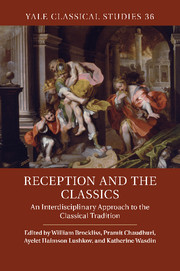Book contents
- Frontmatter
- Contents
- Notes on contributors
- Acknowledgements
- Chapter 1 Introduction
- Part I Reception between Transmission and Philology
- Chapter 2 “Arouse the dead”: Mai, Leopardi, and Cicero's commonwealth in Restoration Italy
- Chapter 3 Honor culture, praise, and Servius’ Aeneid
- Chapter 4 Joyce and modernist Latinity
- Chapter 5 Lyricus vates: musical settings of Horace's Odes
- Part II Reception as Self-Fashioning
- Part III Envoi
- Bibliography
- Index
- References
Chapter 2 - “Arouse the dead”: Mai, Leopardi, and Cicero's commonwealth in Restoration Italy
from Part I - Reception between Transmission and Philology
Published online by Cambridge University Press: 05 December 2011
- Frontmatter
- Contents
- Notes on contributors
- Acknowledgements
- Chapter 1 Introduction
- Part I Reception between Transmission and Philology
- Chapter 2 “Arouse the dead”: Mai, Leopardi, and Cicero's commonwealth in Restoration Italy
- Chapter 3 Honor culture, praise, and Servius’ Aeneid
- Chapter 4 Joyce and modernist Latinity
- Chapter 5 Lyricus vates: musical settings of Horace's Odes
- Part II Reception as Self-Fashioning
- Part III Envoi
- Bibliography
- Index
- References
Summary
A christmas present for the pope
On December 23, 1819, Monsignor Angelo Mai (not to become a cardinal until 1838 as head of the secretariat De propaganda fide), the recently appointed keeper of the Vatican Library, sent a letter to his employer, Pope Pius VII, to announce important discoveries that he had made in two manuscripts in the library. One of them (Vaticanus Latinus 5750) contained portions of the letters of Fronto, of the so-called Bobbio scholia on Cicero's orations, of Symmachus, and of Ulfila's Gothic Bible: these were all palimpsests, the lower (erased) script of parchments that had then been recopied with the Acts of the Council of Chalcedon. Although the texts found were new, the manuscript in fact was one with which Mai was familiar: he had found the rest of the same book a few years earlier in the Ambrosian Library in Milan. The second manuscript, however, was new to him, and he gave it pride of place in his letter: under a copy of Augustine's Enarrationes in Psalmos (on Psalms 119–140) he found 151 leaves of a single work, Cicero's long-lost dialogue De re publica.
Although new discoveries of ancient works still occasionally receive attention, it is hard now even to imagine the degree of interest aroused by Mai's first report of the existence of the manuscript in 1819 and by his subsequent publication of a full edition of the remains of De re publica in 1822. The discovery of the palimpsest of De re publica came near the end of the last great age in which previously unknown ancient texts were unearthed from the libraries of Europe and in which an active and deliberate search for such manuscripts was conducted. In part, the impetus came from the discovery in the previous century of the carbonized papyrus rolls from Herculaneum, which not only revealed important new texts, but showed that much was to be gained from the patient study of fragmentary and difficult manuscripts. A more immediate occasion for the discovery of palimpsests was the disruption of European libraries by the Napoleonic Wars: large numbers of manuscripts had been requisitioned by the conquering French and their return to the libraries from which they had been liberated – or comparably, in France, the vast expansion of the Bibliothèque Nationale resulting from the expropriation of monastic libraries – required the reshelving, and thus almost inevitably the inspection, of entire collections. The existence of palimpsests had been known for more than a century, and some had been published. But it was Mai's own energy and ambition that raised the search to a new level of intensity: the extraordinary number of texts, their importance, and the speed with which he published them beginning in 1814 turned an antiquarian curiosity into a serious and widely followed search.
- Type
- Chapter
- Information
- Reception and the ClassicsAn Interdisciplinary Approach to the Classical Tradition, pp. 19 - 44Publisher: Cambridge University PressPrint publication year: 2011
References
- 1
- Cited by



